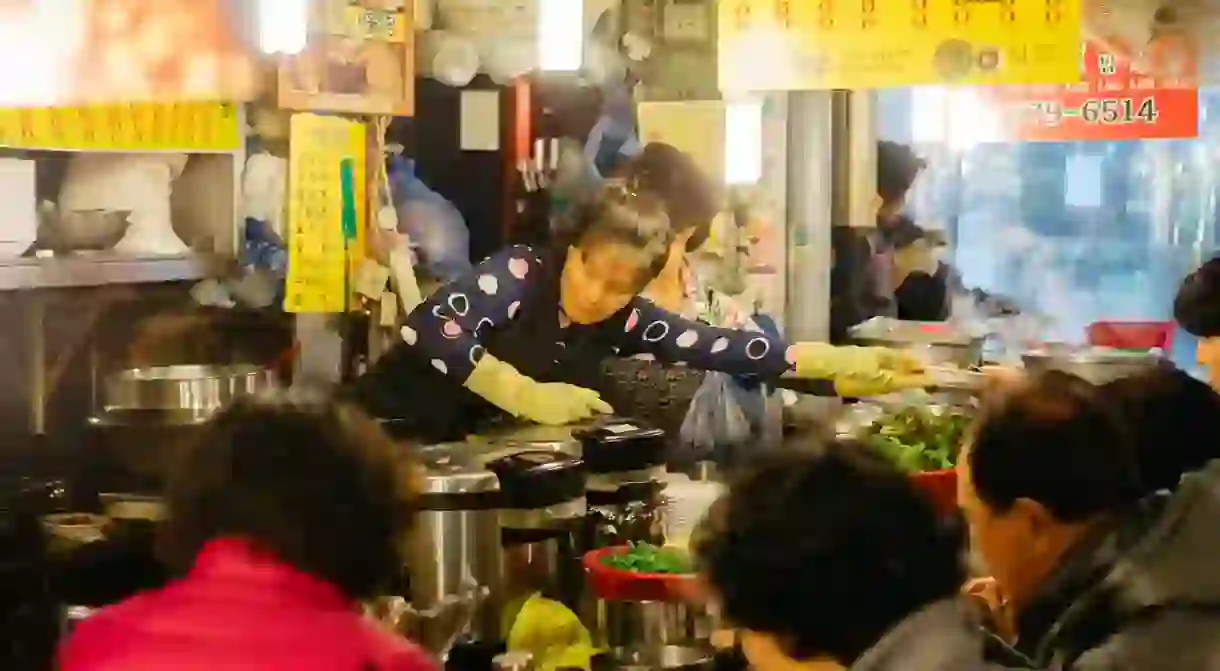A Brief History of Namdaemun Market

The dense maze of more than 10,000 stalls, vendors and restaurants that is Namdaemun Market extends over countless blocks of car-free streets and is perhaps one of Seoul’s most popular tourist destinations. With a past that stretches back some 600 years, the marketplace is not just a space to shop; it’s also one in which to explore the Korean capital’s rich culture and history.
Humble beginnings
Although today Namdaemun Market sells just about every product imaginable, it started out primarily as a fish market in 1414 during the reign of King Taejong of the Joseon Dynasty. It was situated near the old Mapo Port on the Han River, just south of the city’s southern gate, Namdaemun (also known as Sungnyemun).

Known as Chilpae Market, which refers to the king’s guards who were stationed near the area, the space was populated by a number of unlicensed merchants who sold fish brought to the royal capital from the provinces. The market also dealt with other products such as salt, chinaware, rice thatch, bush clover, and bamboo.

Fast forward a century and a half—having experienced the turmoil of the six-year war with Japan (which began in 1592) and the Chinese invasion in 1636, the people of Joseon were in a state of poverty. As a means of survival, they began to flock to the area surrounding Namdaemun to sell what little they had. The Namdaemun district was particularly popular due to its proximity to Seonhyecheong, the equivalent of today’s National Tax Service. Set up by King Seonjo in 1608, the office was responsible for the management of taxes on rice, fabric, and money.

The area soon became the central trading hub for local specialties, not to mention one of the biggest markets in Korea. But it wasn’t until 1897, when Changnae Market was established on the storage lot of Seonhyecheong as part of an effort to modernize the city, that the marketplace began to resemble a more permanent structure rather than a conglomeration of temporary stalls.

The site was thought to be somewhere between buildings A and B in the current market. It comprised some 85 stores, including three produce stores, 14 rice vendors, 36 fish shops, 10 peddlers, and 22 tobacco shops. Open all day, rather than just during the early morning, the market became the country’s first modern permanent market.

A period of turmoil
As Korea began to open to the outside world, merchants from foreign lands also started visiting the market. By 1907, Koreans accounted for half of the vendors, another 20% were Japanese, and 30% were Chinese.

Yet, despite its growing influence, the market felt the impact of Japan’s colonial rule of Korea (1910-1945).

Japan’s Government General of Korea pronounced market rules in 1914 and declared Namdaemun to be outdated in an effort to dismantle the entire marketplace. Interestingly, the market survived thanks to a number of pro-Japanese Koreans who some considered traitors.

Song Byeong-joon, one of the founders of the Iljinhoe, a pro-Japanese political society that promoted the merger of Korea and Japan, took over operations, which hindered the revocation of the market’s license. His company levied hefty rents on merchants and former Japanese government officials. Entrepreneurs managed the market, which racked up profits.

Following the country’s liberation from Japan, merchants established the Namdaemun Merchant Organization and took over management. However, the market fell into ruins during the Korean War (1950-1953) and succumbed to fire in 1953, which completely destroyed more than 1,000 shops.

Endeavors for reconstruction continued in the following years, but financial troubles and organized gangs would prevent the market from flourishing until the Seoul Metropolitan Government transferred the market’s operation rights to the Namdaemun Market Merchants Association in 1957.

A peek into the past
In the years following the Korean War, U.S. military goods were sold illegally in lesser-traversed corners of the market, which sparked nicknames such as “Yankee Market” and “Dokkaebi (Goblin) Market,” as it was said that the merchants would quickly run away (like goblins) after selling their wares to avoid being caught by inspection guards.

By the 1960s and 1970s, Seoul was rapidly expanding and commercializing. At this point, the market offered some of the best quality hand-sewn apparel, especially compared to the nearby Dongdaemun Market, which some thought sold lower-quality and cheaper products.

The emergence of kitchenware, textiles, clothing, and artifacts in the 1980s helped establish the market as one with many specialty stores. A decade later, the market, as many other businesses in South Korea, suffered great losses during the Asian financial crisis. The financial troubles only grew with the propagation of supermarkets in the early 2000s.

However, despite the constant modernization of Korea, Namdaemun continues to flourish.

Rather than boasting gleaming storefronts such as those found at nearby Myeongdong or Gangnam, just south of the Han River, Namdaemun is a treasure trove of humble stores and stalls that not only offer wares of every shape and size, but also a look into a bygone era. Bustling with commerce and consumers at just about every hour, the market continues to teem with life and will no doubt remain a central icon of Korea’s tradition and history for many years to come.














